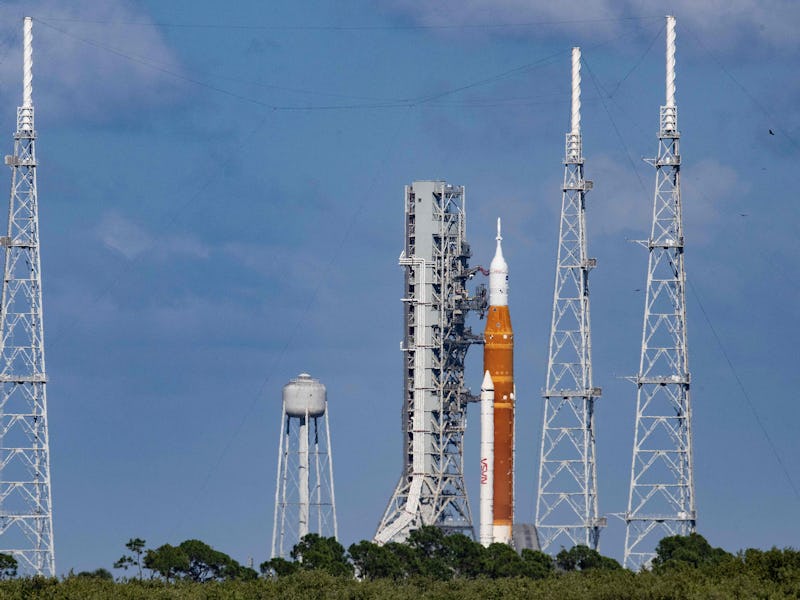NASA confirms Artemis is on track for its November 14 launch attempt
This time it really means it. Really.

Artemis I will try — yet again — to go to the Moon on November 14.
NASA reiterated on November 3 that its upcoming lunar mission is still set to launch on Monday, November 14 at 12:07 a.m. Eastern from NASA’s Kennedy Space Center in Cape Canaveral, Florida. It will begin rolling out of the Vehicle Assembly Building, where it was stowed during Hurricane Ian, at 12:01 a.m. on November 3.
Artemis: Timeline updates
NASA is setting a couple of backup launch dates for the mission on Wednesday, November 16, and Saturday, November 19, though given the long delays of the James Webb Space Telescope, you may as well prepare for a Thanksgiving Day launch. (That’s just idle speculation, but Webb DID launch on Christmas Day.)
Both backup opportunities would also occur during the wee hours of the morning, at 1:04 and 1:45 a.m. Eastern, respectively.
The launch would see the Artemis I mission finally fly after numerous false starts. The massive SLS rocket on which the hope of humanity returning to the Moon is pinned floundered through several “wet” dress rehearsals due to fuel leaks. Undeterred, NASA decided to proceed with launch attempts of the uncrewed mission, first on August 29 and then on September 3, but both were ultimately scrubbed. The first was called off due to potentially faulty sensors, and the second due to persistent fuel leaks — these were issues that arose during the rehearsals, too.
The agency had set a new launch attempt for September 23, but Hurricane Ian delayed that and sent the rocket back to the Vehicle Assembly Building to prevent damage from the storm. During its most recent stint in the VAB, engineers recharged and replaced batteries on the boosters, the Orion capsule, and some of the mission’s secondary science payloads.
But they didn’t touch the cavity that had been the site of those pesky hydrogen fuel leaks during previous launch attempts and rehearsals. According to Cliff Lanham, senior vehicle operations manager, Exploration Ground Systems Program, at Kennedy Space Center, the Artemis team has figured out how to manage the leak by controlling fuel pressures while filling the hydrogen tank — but they still don’t know what caused the problem in the first place.
“There’s not really a smoking gun, per se,” said Lanham.
Hurricane Ian as seen from the International Space Station.
Why go through with Artemis I?
The Artemis I mission is part of NASA’s ambitious Artemis program, which could see astronauts return to the Moon for the first time since 1972. Artemis I is uncrewed and meant to take a 25-and-a-half-day journey to the Moon and back.
It largely will demonstrate the Space Launch System rocket, a sort of Frankenstein rocket of leftover Space Shuttle parts upgraded for heavy launches. On top is the Orion capsule, a roomy vessel designed for humans to live comfortably while on long-duration spaceflight.
“This is a challenging mission. We've seen challenges just getting all our systems to work together, and that's why we do a flight test,” said Jim Free, associate administrator, Exploration Systems Development Mission Directorate, during Thursday’s announcement. “We're learning by taking more risk on this mission before we put crew on there.” One of the big things engineers will be watching during the Artemis I flight is how Orion’s heat shield performs during its return to Earth.
NASA will closely monitor the Artemis I mission to set up Artemis II for success. That mission has a tentative launch date sometime in 2024 and will see astronauts sent in a loop around the Moon. Artemis III will put human boots on the Moon again and is tentatively scheduled for 2025. How the delays to Artemis I play into the return of humans to the Moon, NASA is yet to say.
A lot is riding on the successful launch of Artemis I, and while it’s had its share of hiccups, so too have a lot of NASA missions that have gone on to succeed — see the entire Webb mission. So buckle up for November 14. Or November 16 or 19. Or Thanksgiving. Or sometime in December. But hopefully not in 2023. Hopefully.
This article was originally published on